Looking at Saddles
© Frank Ford, 6/21/00; Photos by FF, 4/20/00
First, I'd like to clear up a point of confusion. In contrast to many other stringed instruments, the flat top guitar's bridge is the saddle and the saddle is the bridge.
OK, that sounds dumb. On an archtop guitar, mandolin, autoharp, banjo, fiddle, cello, and lots of other stringed instruments, the bridge is the piece between the vibrating surface and and the string itself. The saddle of a violin, for example, is the piece at the upper corner edge of the top, against which the tailpiece bears. The adjustable archtop guitar bridge has two parts: the base, and the saddle, over which the strings pass.
On the flat top guitar, the bridge is the big wooden (usually ebony or rosewood) part that holds the strings via holes in back side, or with bridge pins. The saddle is the small structure against which the strings bear, an through which they conduct their vibrating energy. Saddles are usually made of bone, ivory, or a synthetic material, such as Micarta or Corian, both of which are familiar counter top materials. There are also modern synthetics advertised to give the tone of natural materials and to have other desirable characteristics.
I won't spend much time talking about the various saddle materials and their tonal properties in this article. I'm more interested in the mechanics of the saddle - the configuration and strength. Suffice it to say that tone is subjective and we're each entitled to our opinion. Personally, I like bone for its hardness, durability, strength, tone and traditional appearance.
Because the saddle is the termination point of the vibrating string, its position is critical to good intonation. The neck, nut and frets are fixed in their locations, which have been calculated precisely to "divide" the string into appropriate lengths to produce the notes of the musical scale. In order for these vibrating lengths to work out correctly, it's necessary for the saddle to be in the ideal spot. Each string stretches as it is held down to the frets, and as it stretches, its tuning goes a bit sharp. And, each string reacts a bit differently to this stretching action, depending on its composition, its diameter (mass) and the not to which it's tuned.
To "compensate" for this differential change in pitch as the string is fretted, the saddle's position may be adjusted to optimize the results.
Here's a bridge with an adjustable saddle:
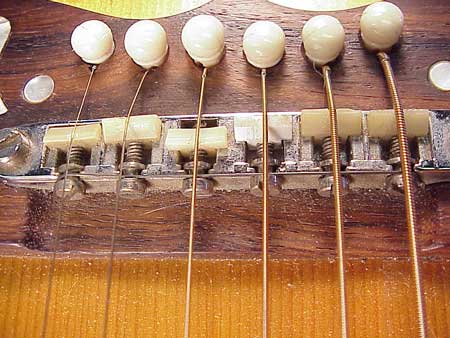
Each little saddle insert may be adjusted for optimum intonation correction. This is a swell idea from the standpoint of tuning. Just "dial in" each string, and the job's done! The only problem is that, tonewise, it sucks. The massive brass and steel hardware is a very effective mute, literally impeding movement of the bridge by the vibrating string. More of the string's energy is "reflected" back on itself, and dissipated as heat, and a bit more vibration of the other anchor point of the string (the peghead.) If you doubt this effect, sit and play an unplugged solid body electric guitar sometime. You'll easily be able to hear the peghead vibrating.
Most steel string designers provide for intonation compensation by striking a compromise between each of the individual ideal saddle positions, placing the saddle at an appropriate angle:

Additionally, the top of the saddle may be cut to allow each string to bear on a point that allows a further kind of "fine tuning" for better intonation.
Some makers use a very wide saddle to allow for individual string lengths to be more precisely determined, while others prefer a divided saddle:

Later on, I'll write more about compensation. For now, I'd like to concentrate on the structural factors that influence the tone of the guitar and structural integrity of the bridge.
Take a look at this bridge:
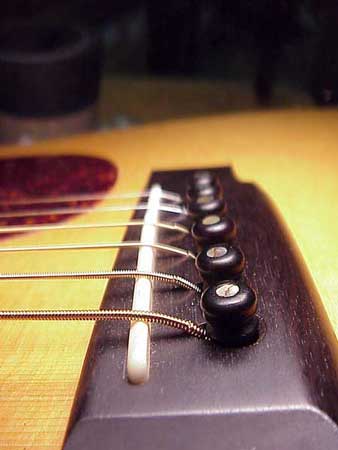
It's what I'd call an ideal saddle setup. The string emerges from the bridge pin hole and makes an angle as it crosses the saddle, pressing downward on the saddle. The downward pressure of the string is very important for tone production.
Try this test: stick your finger under the string in front of the bridge and lift. Go ahead, pull hard. If you can lift the string clear of the saddle, you're not getting enough downward pressure on the saddle. I'm exaggerating just a bit, but really, it should be nearly impossible to lift a tuned string off the saddle.
In the most ideal bridge, I think the saddle should protrude (as it does above) about 3/16" above the wood.
The saddle may sit "captive" in a groove as it does in the bridge above, or it may be inlaid in a channel cut all the way through at the ends, as in this Martin guitar from the 1950s:
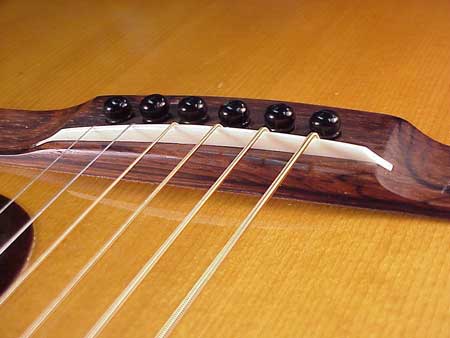
Either way, the saddle works the same. The "through cut" saddle needs to be glued in place to achieve the same strength as the captive one, and is generally considered an obsolete style. Today's under-the-saddle piezo pickup elements make the glued, through cut saddle even more obsolete.
Here's a saddle that's too high:
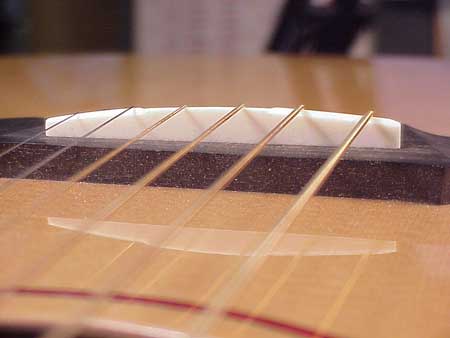
In fact, here's a bridge that's somewhat ill-conceived. Notice that the saddle is not only really high, but that the wooden bridge is flat, while the saddle has quite an arch to match the arcs of the strings and fingerboard. Because it doesn't have good support for the string tension, this bridge is more likely break than one with a lower saddle.
It's a matter of the string angle over the saddle, known as the "break angle." Gee, even this little baritone uke bridge is about to crack under the load of its nylon strings:
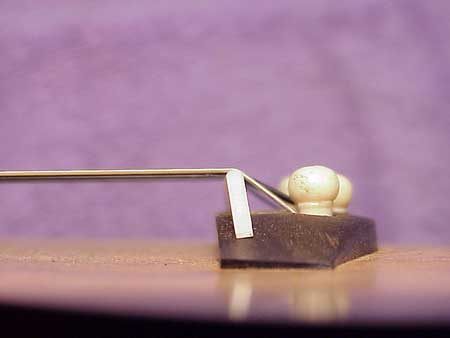
The tension of the strings isn't so great, it's just that the saddle is so darn high.
This guitar bridge has a similar break angle problem:

Here, the saddle is so close to the bridge pin holes that, even though the saddle is an ideal height, the break angle is causing an intense forward pull on the saddle.
Saddles with this kind of break angle are under a lot of pressure. Sometimes, they will break the front of the bridge. Sometimes the saddle itself will break. With this kind of load, the strings will cut or crumble little notches into the saddle, regardless of whether it's bone, ivory, or synthetic.
Strings with a "strong" break angle, soft saddle material, or simply the passage of time can result in the saddle developing these little notches under each of the strings. Sitting in the little notches, the strings will be held quite rigidly and not allowed to "roll" microscopically side-to-side. For hard driving flatpickers, this is often the cause of premature string breakage at the saddle. Additionally, the extra bend of the string over a very high saddle puts even more strain on the string at that point.
More